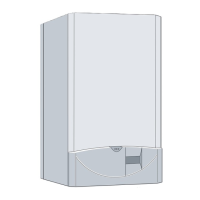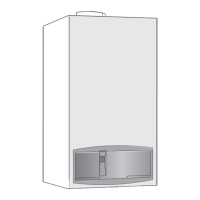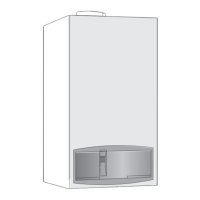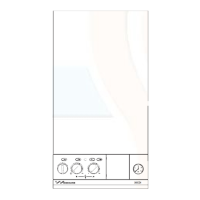A separate combustion air opening in any room or compartment
is
not required.
Do
not place anything on top of the appliance.
If
the
appliance is fitted into a compartment,
the
compartment
must
conform to the requirements of
BS
6798: 1987: Section 6.
The clearances specified for servicing
must
be maintained.
There
is
space
for
the gas and water pipes to pass up the back of
the appliance and to come
out
at
the top. See Section 10
.2.
2.8
FLUE.
The appliance has a multi-directional horizontal fanned flue sys-
tem-right,
left or rear.
The standard
flue
assembly length
is
from 1 00
mm
(4
in.)
to 1000
mm
(39
.3
in
.)
An
extended
flue length from 1001
mm
(39.4 in.) to
2000
mm
(78.7
in.)
is available.
Do
not
allow
the
flue
terminal
fitted into
the
outside
wall to
become obstructed or damaged.
A terminal guard,
'!Ype
K2,
CG
393 553,
is
available from Tower
Flue
Components,
Vale
Rise
,
Ton
bridge
TN9
1
TB
.
An
internal
flue fixing
kit
is available
from
Worcester
Heat
systems.
The Instructions for fitting
the
flue
are
in
this book-
let. See Section 1 0.3.
2.
9 CONTROLS.
Separate circulating pumps control the central heating and dom-
estic
hot
water
flow
systems.
The electronic control system
and
gas valve modulate the
heat
input
in
response to the central heating and domestic hot water
temperatures between minimum and maximum settings.
The control circuit provides automatic burner ignition. A
perma-
nent pilot
is
not used.
The Operating Switch provides for the selection of Domestic Hot
Water only or
Central Heating
and
Domestic Hot Water or
Off.
A facia mounted programmer
is
available as an optional extra. A
remote mounted programmer may be connected to the appliance.
The integral facia displays indicate the status of the appliance.
There
is
provision
for
the connection of a mains voltage room ther-
mostat
and
/ or a frost thermostat.
The electronic controls prevent rapid cycling of the appliance in
the central heating mode.
The water system low pressure cut-off switch
is
set to operate
at
0.5
bar
(7
.4 psi).
2.1
0 SYSTEM NOTES.
IMPORTANT.
Check
that
no foreign
matter
is left in either the gas
or water pipework as this could cause damage to the appliance.
The primary system should be flushed and treated in accordance
with the recommendations of
BS
7593:1992.
The
appliance
is
NOT
suitable for fitting to an open vented system.
The water pipe connections throughout the heating system
must
be capable of sustaining a pressure of up to 3 bar.
Radiator valves
must
conform to the requirements
of
BS
2767(10):
1972.
The relief valve drain outlet must be directed away from any
elec·
trical components or where it would cause a hazard to the user.
For
circuit design purposes it
is
important
that
due note
is
taken of
the
information given in Table 3 relating to the available
pump
head.
A drain cock to
BS
2879
must
be fitted to the lowest point of the
system.
2.11
SHOWERS, BIDETS, TAPS AND MIXING
VALVES.
Hot and cold taps and mixing valves used
in
the system
must
be
suitable
for
operating
at
mains pressure.
Thermostatically controlled shower valves
will
give extra comfort
and guard against the
flow
of water
at
too high a temperature.
Hot
and
cold mains fed water can be supplied direct to an over-
3
rim flushing bidet
but
is
subject to local Water Company require-
ments.
With all mains fed systems, the
flow
of water from the individual
taps
will
vary with the number of outlets operated simultaneously
and
the cold water mains supply pressure to the property. Flow
balancing using
'
Ball-o·
Fix
' type valves
is
recommended to avoid
an excessive reduction in flow to individual outlets. For further
information contact Worcester Heat Systems
Ltd.
2.1 2
GAS
SUPPLY.
The
boiler requires 4.12 m
3
/ h (144.5 ft
3
/
hr)
of gas. The gas meter
and
supply pipes
must
be capable of supplying this quantity of
gas in addition to the
demand
from any other appliances being
served.
Table
7 gives an indication of limiting gas pipe lengths and
the allowance to be made for fittings.
Refer
to
BS
6891
for
further
information.
The meter governor should deliver a dynamic pressure of
20
mbar
(8
in.wg.)
at
the appliance, equivalent to a pressure of about 18.5
-1 9
mbar
at
the
gas valve.
The complete installation, including the meter,
must
be tested for
soundness and purged.
See
BS
6891.
2.13
SAFETY CONSIDERATIONS.
The appliance
must
not be operated in a waterless condition.
The appliance
must
not be operated with the boiler inner casing
cover removed.
Work
must
not be carried
out
on the appliance without
the
gas
and electricity supplies being turned off.
Checks
must
be
made
to ensure
that
the
ventilation openings
made into walls
and
partitions are of the correct size and are not
obstructed.
2.14
OPERATION.
Domestic
Hot
Water
Mode: With a
demand
for
hot
water
the
burner
will
light
at
its minimum setting and immediately increase
to the maximum output. The temperature of the water
at
the
tap
rapidly rises to its maximum set
level.
The output of the appliance
is
then automatically adjusted to maintain the temperature rise of
the delivered water.
When hot water
is
no longer required the burner goes out. The fan
will overrun for a few seconds to dissipate the residual heat from
the appliance.
In
winter, when the mains inlet temperature
is
low, it
will
be
nec-
essary to reduce the flow of water from
the tap
to maintain the
delivery temperature.
Central
heating
Mode: With a demand
for
heating the burner
will
light
at
its minimum setting and gradually increase to the maxi-
mum
output
of between 1 5kW
and
25kW depending
upon
the
setting.
The
output of the appliance
is
then automatically adjusted
to maintain the temperature of the system. The output can reduce
down
to a minimum of 9.
0kW.
If
the
system
no longer requires
even the minimum output to maintain the desired room tempera-
ture then the burner
will
extinguish. The fan
will
overrun for a
few
seconds to dissipate
the
residual
heat
from
the
appliance. The
appliance will remain
off
for a fixed period of about three minutes
before re-lighting and
will
automatically meet the system require-
ment.
Domestic Hot Water
and
Central Heating Mode: The appliance
will
supply
heat
to
the
central
heating
system
as
required. A
demand
for hot water
at
a tap or shower will override the central
heating requirement for the period of
hot
water
demand
. When
hot water is no longer required
the
burner will extinguish
and
a
waiting period of about three minutes
will
prevail before returning
to the central heating state and its normal mode of operation.
The
fan overrun function
will
only come into operation
if
neither pump
is
operating.
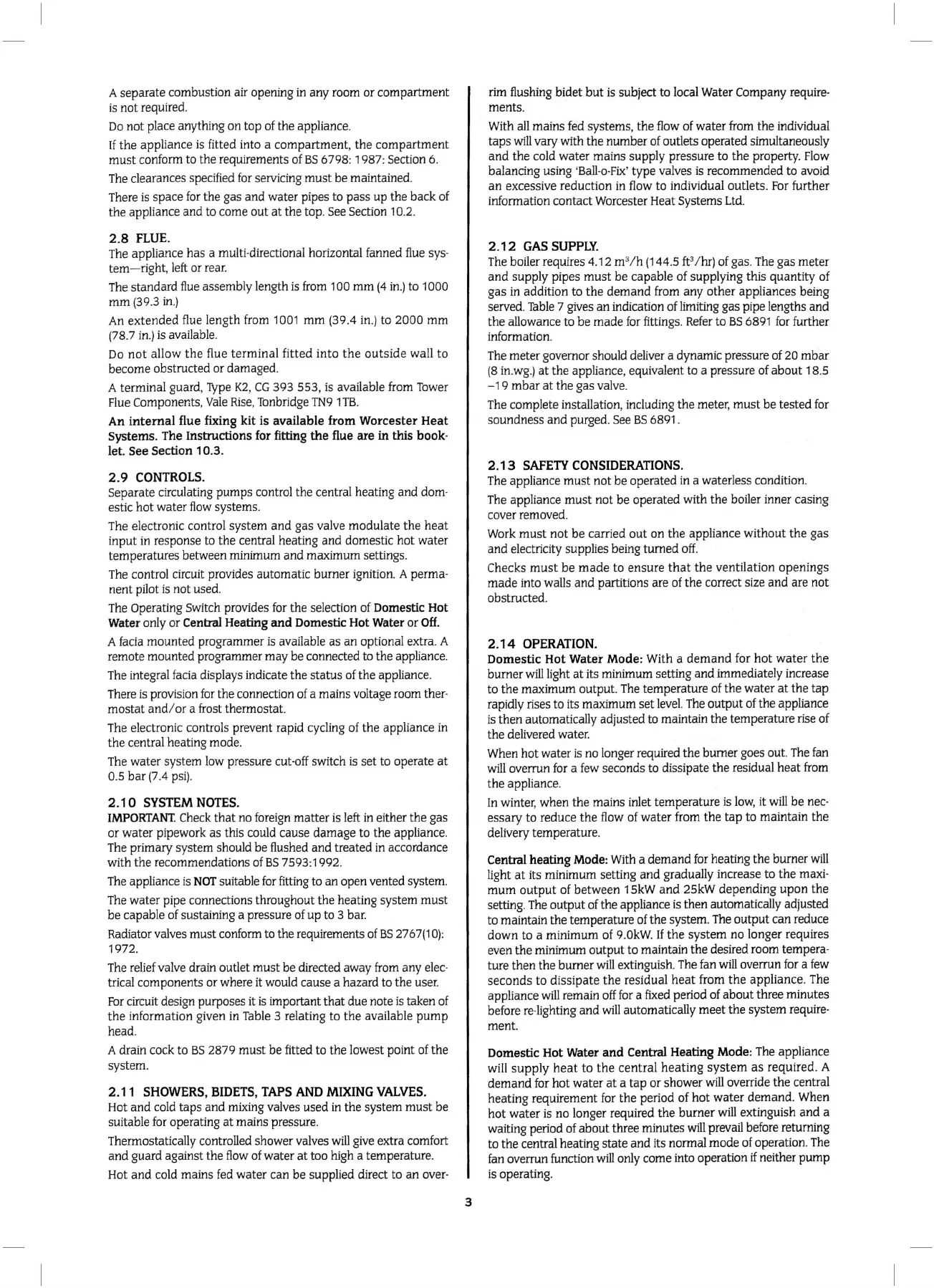